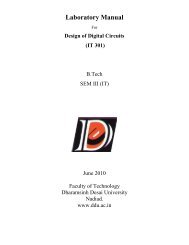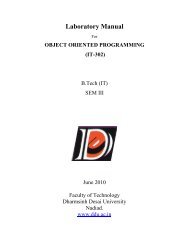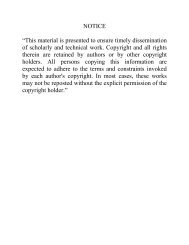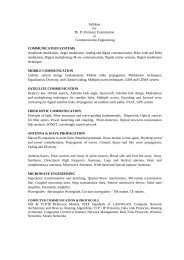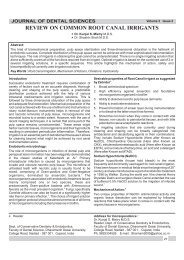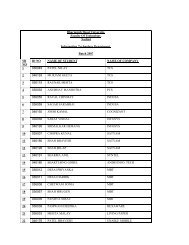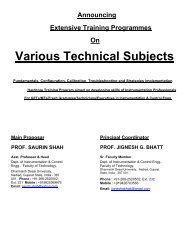5.wonderful world of endodontic working width–the - Dharmsinh ...
5.wonderful world of endodontic working width–the - Dharmsinh ...
5.wonderful world of endodontic working width–the - Dharmsinh ...
Create successful ePaper yourself
Turn your PDF publications into a flip-book with our unique Google optimized e-Paper software.
JOURNAL OF DENTAL SCIENCES<br />
Reader<br />
Department <strong>of</strong> Conservative Dentistry and Endodontics<br />
Faculty <strong>of</strong> Dental Science, Dharamsinh Desai University.<br />
Nadiad - 387 001. Gujarat, India<br />
Lecturer<br />
Dept <strong>of</strong> Physiology, Faculty <strong>of</strong> Dental Science,<br />
<strong>Dharmsinh</strong> Desai University, Nadiad - 387001. Gujarat, India<br />
Dr. Shashin J. Shah M.D.S., F.R.S.H.<br />
Dr. Jayshree S. Shah M.S.<br />
Volume 2 Issue 2<br />
WONDERFUL WORLD OF ENDODONTIC WORKING WIDTH<br />
–THE FORGOTTEN DIMENSION – A REVIEW<br />
Abstract:<br />
Working width- if you are familiar with this term – It was first used by Dr.Jou from the University <strong>of</strong> Pennsylvania. He<br />
emphasized on this as a valuable reminder that canals are three – dimensional. This means that all instrumentation<br />
techniques have to contend with both a <strong>working</strong> length and a <strong>working</strong> width. Incidentally, this area <strong>of</strong> the canal (coronal to<br />
the apical constriction) was called, and with good reason, “The Forgotten Dimension” by Carl Hawrish, an endodontist from<br />
Canada.<br />
Techniques for cleaning and shaping root canals differ in accordance with clinical observations, research discoveries and<br />
traditionally accepted values.<br />
Our goal should be to avoid both under and over preparation <strong>of</strong> the canal. Achieving this doesn’t seem to be a mystery<br />
anymore. Anatomical research tells us that canals come in many different diameters, from narrow to wide and from straight<br />
to extremely curved.<br />
Key words: WW [Working Width], WL [Working Length], IWW [Initial Working Width], FWW [Final Working Width],<br />
Instrumentation, Major Diameter, Minor Daimeter.<br />
Introduction :<br />
Root canal morphology is a critically important part <strong>of</strong><br />
conventional and surgical <strong>endodontic</strong>s. Many in vitro<br />
1,2,3,4,5<br />
studies have recorded the scales and average sizes <strong>of</strong><br />
root canals, but there have been few clinical attempts to<br />
determine the <strong>working</strong> width [WW] . The initial and post<br />
instrumentation horizontal dimensions <strong>of</strong> the root canal<br />
system at WL and other levels The horizontal dimension <strong>of</strong><br />
the root canal system is not only more complicated than the<br />
vertical dimension (root canal length or <strong>working</strong> length) but<br />
also more difficult to investigate because the horizontal<br />
dimension( root canal width or <strong>working</strong> width)varies greatly at<br />
each vertical level <strong>of</strong> the canal. It goes without saying that as<br />
pr<strong>of</strong>essionals we should strive for the highest possible<br />
success rate <strong>of</strong> root canal therapy. Successful cases should<br />
be fully functional and pain–free. Similarly, how much time<br />
should elapse, until you can consider a root canal treatment<br />
6<br />
successful? Three years is a common figure. Inadequate<br />
and even very poorly done root canal treatment <strong>of</strong>ten last at<br />
least that long or even longer- thanks to an efficient host<br />
immune system.<br />
It is known that most true <strong>endodontic</strong> failures are caused<br />
by:[1] Inadequate pulpal space cleaning,<br />
[2] Inadequate disinfection,both are simultaneously<br />
interrelated.In dental schools we are taught that cleaning and<br />
sealing the root canals especially in the apical third, is the<br />
most critical part <strong>of</strong> the procedure. This basic concept has not<br />
changed. Anatomical criteria also plays an important role as<br />
root canals are curved in one or more directions. Shape also<br />
varies from oval, round, cylindrical, rhomboidal, double –<br />
pear shaped etc.<br />
Review <strong>of</strong> literature :<br />
A clinician’s primary concern is to thoroughly cleanse the root<br />
canal system during root canal therapy, mechanically and<br />
chemically removing microorganisms and their substrates<br />
from the canal. Without proper chemo mechanical<br />
instrumentation, the remaining irritants may reduce the<br />
success rate and cause failure <strong>of</strong> the treatment. In addition,<br />
canal surface irregularities require proper instrumentation for<br />
adequate root canal filling. Many textbooks and much<br />
literature focus on canal instrumentation in terms <strong>of</strong> filing,<br />
reaming, or other instrument motions and usage and always<br />
stress the importance <strong>of</strong> enlarging the canal size. Without<br />
solid scientific evidence, however, it is still not clear how large<br />
is large enough.<br />
There is widespread agreement among endodontists that<br />
cleaning & shaping <strong>of</strong> the root canal is the most important<br />
7,8<br />
phase in <strong>endodontic</strong> therapy .The aim <strong>of</strong> <strong>endodontic</strong><br />
treatment is chemomechanical cleaning <strong>of</strong> the root canal and<br />
9<br />
its obturation hermatically with an inert material. Ingle et al<br />
have suggested that apical percolation is the main cause <strong>of</strong><br />
<strong>endodontic</strong> failure. The main reasons for this failures are<br />
incomplete canal obturation or the presence <strong>of</strong> an untreated<br />
canal, for successful <strong>endodontic</strong> therapy the dentist should<br />
be aware <strong>of</strong> the variations in the root canal morphology. Many<br />
investigators have worked on the tooth morphology,<br />
topography, curvature, ramifications <strong>of</strong> the main root canal,<br />
diameters, localization and no. <strong>of</strong> foramina, and apical deltas<br />
10,11<br />
by using different methods .Since there are differences in<br />
Address for Correspondence:<br />
Dr. Shashin J. Shah M.D.S., F.R.S.H.<br />
Faculty <strong>of</strong> Dental Science, <strong>Dharmsinh</strong> Desai University.<br />
College Road, Nadiad - 387001. Gujarat, India<br />
Phone : +91 079 27471883, 27551624, +91 268 2527077<br />
Mobile : +91 98252 50405<br />
Email : smartyrushabh@gmail.com<br />
20
JOURNAL OF DENTAL SCIENCES<br />
selection <strong>of</strong> material, methods used, and classification <strong>of</strong><br />
canal configurations different opinions have arisen about root<br />
12,13<br />
canal morphology .<br />
Many studies have also demonstrated that widely accepted<br />
<strong>endodontic</strong> cleaning and shaping techniques are inadequate.<br />
1<br />
Haga found that mechanical preparation <strong>of</strong> root canal to two<br />
sizes larger than original was still not adequate. Gutierrez and<br />
14<br />
Garcia showed that <strong>of</strong>ten, canals are improperly cleaned.<br />
They attributed this inadequate instrumentation to the fact<br />
that root canal diameter is larger than the instrument caliber<br />
used in each particular case. This finding suggests that each<br />
canal should be calibrated independently before<br />
instrumentation so that proper preparation can be achieved.<br />
15<br />
Walton’s histologic study showed that canals that were<br />
instrumented to three sizes larger still were not thoroughly<br />
16<br />
cleaned. Recent in- vitro investigations concluded that<br />
stainless steel and nickel-titanium [NiTi] rotary instruments<br />
were not able to clean the root canals satisfactorily.<br />
In the absence <strong>of</strong> a study that defines what the original width<br />
and optimally prepared horizontal dimensions <strong>of</strong> canals are,<br />
clinicians are making treatment decisions without any<br />
support <strong>of</strong> scientific evidence. It is difficult to section all levels<br />
<strong>of</strong> the teeth and make the section plane exactly perpendicular<br />
to the canal curvature. Therefore, most morphometric studies<br />
cannot show the true picture <strong>of</strong> the horizontal dimensions <strong>of</strong><br />
the root canal system. Until recently, most investigations<br />
have involved counting the number <strong>of</strong> canals and foramina<br />
and categorizing how the canals join or split. Current studies<br />
pay more attention to the shape <strong>of</strong> the canal systems and its<br />
clinical implications than to the actual preoperative size <strong>of</strong> the<br />
17,18,19<br />
canal .<br />
Routine clinical radiographs may mislead clinicians to make a<br />
different plan to clean the root canal system. Unfortunately,<br />
this area <strong>of</strong> critical importance hasn’t been investigated<br />
thoroughly. Some clinicians may still have the impression that<br />
all root canals are round in shape because <strong>of</strong> radiographs.If<br />
we see radiograph in Illus.1 & 2 – the actual difference <strong>of</strong><br />
dimensions <strong>of</strong> root canal area (Diameter) mesio distally and<br />
18<br />
facio lingually is noticeable. Recent studies reported a high<br />
prevalence <strong>of</strong> oval root canals in human teeth. Crosssections<br />
<strong>of</strong> 90% <strong>of</strong> the mesiobuccal canals <strong>of</strong> maxillary first<br />
molars were found to be oval or flat. This article provides<br />
definitions and perspectives on the current concepts and<br />
techniques to handle WW (the horizontal dimension <strong>of</strong> the<br />
root canal system) and its clinical implications.<br />
Illustration 1 The mesiodistally directed radiograph<br />
indicates a flattened distal root canal in a mandibular first<br />
molar. In the same tooth, the faciolingual direction <strong>of</strong> the<br />
routine radiograph gives an impression <strong>of</strong> a round-shaped<br />
distal canal.<br />
22<br />
(TAKEN FROM JOU Y T- DENT CLIN NORTH AM )<br />
Volume 2 Issue 2<br />
Illustration 2. The faciolingual direction <strong>of</strong> the routine<br />
radiograph gives an impression <strong>of</strong> roundshaped canal in a<br />
mandibular first premolar. The mesiodistally directed<br />
radiograph indicates a flattened root canal in the same tooth.<br />
22<br />
(TAKEN FROM JOU Y T- DENT CLIN NORTH AM )<br />
Determination <strong>of</strong> the minimal and maximal final <strong>working</strong><br />
width at <strong>working</strong> length:<br />
To what extent the canal is supposed to be prepared has been<br />
20<br />
a myth in the <strong>endodontic</strong> field. Grossman described the<br />
rules governing biomechanical instrumentation in his<br />
textbook Endodontic Practice.<br />
Two guidelines were considered sufficient for<br />
instrumentation:<br />
[1] Enlarge a root canal at least three sizes beyond the size<br />
<strong>of</strong> the first instrument that binds;<br />
[2] Enlarge the canal until clean, white dentinal shavings<br />
appear in the flutes <strong>of</strong> the instrument blade.<br />
Root canals should be enlarged, regardless <strong>of</strong> initial width, to<br />
remove irregularities <strong>of</strong> dentin and to make the walls <strong>of</strong> the<br />
canal smooth and tapered.<br />
Root canals should be widened for four reasons:<br />
[1] To remove microorganisms on the canal surface<br />
mechanically.<br />
[2] To remove pulp tissue ,because even when a vital pulp is<br />
extirpated, tags <strong>of</strong> pulp tissue and odontoblasts cling to<br />
the canal wall and are not removed with the body <strong>of</strong> the<br />
pulp; they later undergo necrosis and provide an<br />
environment for bacterial growth.<br />
[3] To increase the capacity <strong>of</strong> the root canal, to permit<br />
irrigating solutions to reach the apical third <strong>of</strong> the root<br />
canal for effective debridement.<br />
[4] To shape the root canal to receive gutta-percha,<br />
because the wider the canal, the easier it is to fill it.<br />
Definition <strong>of</strong> <strong>working</strong> width<br />
21<br />
Working width is defined as:<br />
“The initial and post instrumentation horizontal dimensions <strong>of</strong><br />
the root canal system at WL and other levels”.<br />
• Minimum initial <strong>working</strong> width (Min IWW) corresponds to<br />
the initial apical file size that binds at the WL.<br />
• The maximum final <strong>working</strong> width (Max FWW)<br />
corresponds to master apical file size that is generally<br />
three ISO sizes larger than the Min IWW.<br />
21
JOURNAL OF DENTAL SCIENCES<br />
Working<br />
Width<br />
MinlWW MaxFWW<br />
The factors affecting the determination <strong>of</strong> Min IWW are:<br />
• Canal shape<br />
• Canal length<br />
• Canal taper<br />
• Canal curvature<br />
• Canal contents<br />
• Canal wall irregularity<br />
• Type <strong>of</strong> instruments used to determine the initial WL<br />
In a round canal, it is easy to determine the <strong>working</strong> width, but<br />
in canals that are oval, long oval, flattened ribbon like or<br />
irregular, discrepancy arises leading to incomplete cleaning<br />
and produces a “key hole” or a“dumb bell” preparation <strong>of</strong> the<br />
root canal.<br />
Illustration 3. Cross-section <strong>of</strong> a Mandibular first premolar,<br />
indicating a long-oval and irregular rootcanal. In the same<br />
tooth, the faciolingual direction <strong>of</strong> the routine radiograph may<br />
be mistakenly recognized as a round-shaped canal because<br />
a mesiodistally directed radiograph is rarely available<br />
clinically.<br />
22<br />
(TAKEN FROM JOU Y T- DENT CLIN NORTH AM )<br />
Current descriptions <strong>of</strong> the horizontal dimensions (crosssections)<br />
<strong>of</strong> the root canal.<br />
1. Round (circular) : MaxIWW equals MinIWW<br />
2. Oval : MaxIWW is greater than MinIWW (upto two<br />
times more)<br />
3. Long Oval : MaxIWW is two or more times greater than<br />
MinIWW (upto four times more)<br />
4. Flattened (flat, ribbon) : MaxIWW is four or more times<br />
greater than MinIWW.<br />
5. Irregular : cannot be defined by 1-4.<br />
22<br />
(TAKEN FROM JOU Y T- DENT CLIN NORTH AM )<br />
21<br />
Significance <strong>of</strong> <strong>working</strong> width<br />
• To obtain an apical stop which is as round as possible so<br />
as to get an impermeable seal<br />
• So that the dentinal tubules at the apical 1 mm is devoid<br />
<strong>of</strong> any micro organism.<br />
Volume 2 Issue 2<br />
• Apical preparation width with large <strong>working</strong> width<br />
removes more bacteria than small apical preparation. It<br />
also permits irrigation solutions to be placed closer to<br />
WL with easier exchange <strong>of</strong> irrigants.<br />
The initial and post instrumentation horizontal dimensions <strong>of</strong><br />
the root canal system at <strong>working</strong> length and other levels are<br />
different at different levels in a relatively round canal, the<br />
lesser and the greater initial horizontal dimensions are<br />
approximately the same. In an oval, long oval or flat canal (as<br />
shown in Box), the maximal initial horizontal dimension<br />
(MaxIWW) may be several times larger than the minimal<br />
initial dimension (MinIWW) at different levels <strong>of</strong> the canal. For<br />
22<br />
example, in a maxillary cuspid , MinIWW at <strong>working</strong> length<br />
(MinIWW0) may be the same as MaXIWW at <strong>working</strong> length<br />
(MaxIWW0). But 12 mm short <strong>of</strong> <strong>working</strong> length, its<br />
MaxIWW12 is probably three to four times larger than<br />
MinIWW12. This is because at that level, the cross section <strong>of</strong><br />
a cuspid very <strong>of</strong>ten is a long oval or flat canal shape.<br />
Determination <strong>of</strong> initial <strong>working</strong> width at <strong>working</strong> length<br />
(initial apical file determination estimation <strong>of</strong> initial canal<br />
diameter)<br />
In the course <strong>of</strong> cleaning and shaping the root canal system,<br />
the clinician must determine three critical parameters. These<br />
are the length <strong>of</strong> the canal, the taper <strong>of</strong> preparation, and the<br />
horizontal dimension <strong>of</strong> the preparation at its most apical<br />
extent, also referred to as the initial apical file size.<br />
Factors affecting the determination <strong>of</strong> minimal initial<br />
<strong>working</strong> width at <strong>working</strong> length<br />
Several factors may affect the accuracy <strong>of</strong> determining the<br />
MinIWW0. The canal shape, length, taper, curvature,<br />
content, and wall irregularities and the instrument used may<br />
all influence the result because each can affect the clinician’s<br />
tactile sense. The combination <strong>of</strong> those factors makes correct<br />
determination <strong>of</strong> IWW very difficult, if not impossible.<br />
Understanding these factors can minimize the<br />
underestimation <strong>of</strong> the IWW.<br />
Canal shape<br />
The variation <strong>of</strong> canal shape as stated earlier, the round canal<br />
can be measured more easily because the MinIWW and<br />
MaxIWW are the same. Other factors, however, make<br />
determination <strong>of</strong> IWW difficult, even in straight canals. The<br />
proper instrument and tactile sensation may determine the<br />
MinIWW <strong>of</strong> the oval, long oval, and flat canals. The<br />
determination <strong>of</strong> MaxIWW, however, cannot easily be<br />
realized with current methods.<br />
One <strong>of</strong> the most common method to evaluate canal shape is<br />
sectioning <strong>of</strong> the root. Cross sections at different level in a<br />
root allows direct viewing <strong>of</strong> canal shape & position relative to<br />
23,24<br />
the borders <strong>of</strong> the root surface<br />
Canal length<br />
When using an instrument to gauge <strong>working</strong> length, the<br />
longer the canal, the greater the frictional resistance. In a very<br />
long canal (>25 mm), the frictional resistance may increase to<br />
affect the clinician’s tactile sense for determining the IWW<br />
correctly. In addition, if the coronal flare is too conservative or<br />
limited to the coronal third <strong>of</strong> the canal, then the shaft <strong>of</strong> the<br />
22
JOURNAL OF DENTAL SCIENCES<br />
instrument may engage the canal wall and cause a<br />
false/premature conclusion as to WW.<br />
Canal taper<br />
Any tapering discrepancy between the gauging instrument<br />
and canal may lead to an early instrument engagement <strong>of</strong> the<br />
canal wall, causing a false sensation <strong>of</strong> apical binding. Early<br />
coronal flare can increase the taper <strong>of</strong> the canal and reduce<br />
the tapering discrepancy between the gauging instrument<br />
and canal wall. The last 3 to 5 mm <strong>of</strong> the canal can have<br />
parallel walls, making correct determination <strong>of</strong> IWW difficult.<br />
Canal curvature<br />
Curved canals can cause deflection <strong>of</strong> the gauging<br />
instrument and increase the frictional resistance. The<br />
curvature <strong>of</strong> the root canal can be categorized into twodimensional,<br />
three-dimensional, small radius, large radius,<br />
and double curvature (S-shaped, bayonet-shaped) and with<br />
different degrees <strong>of</strong> severity. Each <strong>of</strong> these curvatures has a<br />
different effect on a clinician’s tactile sense. The combination<br />
<strong>of</strong> these curvatures makes correct determination <strong>of</strong> IWW<br />
extremely difficult, if not impossible. In curved mandibular<br />
25<br />
premolars, the study by Wu et al indicated that the first K file<br />
and the first Light speed instrument that bound at the <strong>working</strong><br />
length failed to accurately reflect the diameter <strong>of</strong> the apical<br />
canal. Careful canal Preparation is an important part <strong>of</strong><br />
Successful root canal therapy. The ability to enlarge a canal<br />
without deviation from the original canal curvature is a<br />
9,26,27<br />
primary objective in <strong>endodontic</strong> instrumentation . It has<br />
been stated that “The final Preparation should be an exact<br />
replica <strong>of</strong> the original canal Configuration in shape, taper and<br />
28<br />
flow, only larger” . After studying the effects <strong>of</strong> several<br />
26<br />
instrumentation techniques, Weince et al noted that every<br />
file,whether precurved or straight , tended to straighten within<br />
the canal. They reported that the largest amount <strong>of</strong> apical<br />
canal preparation occurred at the outer portion <strong>of</strong> the<br />
curvature, away from the furcation. An attempt to solve this<br />
problems has led to the development <strong>of</strong> various<br />
instrumentation technique like step back, crown down,<br />
balanced force, anti curvature filling etc in addition several<br />
instruments like k flex, flex arc, flex-o, protaper, race files,<br />
light speed, hero shaper-hands and rotary files have been<br />
designed. This instruments aim at alleviating procedural<br />
difficulties at coronal, middle, apical regions <strong>of</strong> root canal.<br />
The Schneider method is the primary technique used to<br />
28<br />
measure canal angulation .<br />
Canal content<br />
The content <strong>of</strong> the root canal may be fibrous in nature.<br />
Calcified material (calcific metamorphosis) may also be part<br />
<strong>of</strong> the canal content. During determination <strong>of</strong> IWW, the mixed<br />
canal contents can create different degrees <strong>of</strong> frictional<br />
resistance against the gauging instrument. It can eventually<br />
affect the clinician’s tactile sense. This factor makes correct<br />
determination <strong>of</strong> IWW somewhat more difficult.<br />
Canal wall irregularities<br />
Attached pulp stones, denticles, and reparative dentin canal<br />
create convexities on the canal wall surface. Resorption can<br />
produce concavities on the canal wall surface. These<br />
phenomena can serve as an impacting factor that induces a<br />
Volume 2 Issue 2<br />
false estimation <strong>of</strong> the true canal dimension at <strong>working</strong> length<br />
and other levels.<br />
22<br />
(TAKEN FROM JOU Y T- DENT CLIN NORTH AM )<br />
Instrument for determining initial <strong>working</strong> width<br />
The rigidity, flexibility, and tapering <strong>of</strong> the instrument used for<br />
determining IWW can affect accuracy. As mentioned<br />
previously, any tapering discrepancy between the gauging<br />
instrument and canal may lead to an early instrument<br />
engagement <strong>of</strong> the canal wall, altering the tactile sensation. In<br />
addition, the rigid instrument in a curved canal also can lead<br />
to a false tactility. During IWW determination, the combination<br />
<strong>of</strong> those affecting factors can have a great impact on the<br />
accuracy. Understanding these factors can minimize the<br />
underestimation <strong>of</strong> the IWW and maximize its accuracy.<br />
Eliminating or minimizing the influence <strong>of</strong> affecting<br />
factors:<br />
Being aware <strong>of</strong> the existence <strong>of</strong> the affecting factors in IWW<br />
determination is the primary step in maximizing the accuracy<br />
<strong>of</strong> the technique. Without knowing these factors, clinicians<br />
can repeatedly make the same mistakes in underestimating<br />
IWW, which will lead to incomplete cleaning and shaping <strong>of</strong><br />
the root canal system as shown in Illustration 4-6. (TAKEN<br />
22<br />
FROM JOU Y T- DENT CLIN NORTH AM )<br />
Illustration 5. A cross-section <strong>of</strong> prepared and filled canals<br />
indicates an incomplete instrumentation and may result in a<br />
failed root canal treatment. The ‘‘dumbbell’’ effects are typical<br />
pictures that demonstrate the unprepared parts <strong>of</strong> the root<br />
canal. This misadventure can come from underestimation <strong>of</strong><br />
the IWW and the lack <strong>of</strong> understanding <strong>of</strong> <strong>endodontic</strong><br />
WWconcepts<br />
23
JOURNAL OF DENTAL SCIENCES<br />
Illustration 6 A cross-section <strong>of</strong> incompletely prepared and<br />
filled canals demonstrates the complicated situation <strong>of</strong><br />
<strong>endodontic</strong> WW. Understanding the concepts and the<br />
techniques <strong>of</strong> <strong>endodontic</strong> WW can minimize misadventures<br />
<strong>of</strong> incomplete instrumentation & a failed root canal treatment.<br />
Before the IWW determination, it is suggested to widen the<br />
orifices, to do early coronal flaring and additional canal flaring<br />
(crown down, double flaring ) to ensure effective irrigation,<br />
and minimize any interferences with tactile sensation.<br />
Carefully selecting the adequate instrument <strong>of</strong> maximal<br />
flexibility and minimal taper such as Light Speed may avoid<br />
interference and help to achieve better results.<br />
Ideally, root canal preparation should follow the exact outline<br />
<strong>of</strong> the horizontal dimensions <strong>of</strong> the root canal at every level <strong>of</strong><br />
the canal. In this ideal condition, especially for long oval and<br />
flattened root canals, they can be cleaned and shaped<br />
properly with minimal mishaps <strong>of</strong> weakening, stripping, or<br />
perforating the canal walls as shown in Illustration 4D.<br />
Circumferential preparation or instrumentation may have to<br />
be considered for these cases to minimize incomplete<br />
cleaning <strong>of</strong> the root canal system. Most <strong>of</strong> the NiTi rotary<br />
instruments provide a continuous reaming action that makes<br />
the canal relatively circular in shape. Indiscriminate use <strong>of</strong><br />
NiTi rotary instruments alone for root canal cleaning and<br />
shaping may result in incomplete cleaning <strong>of</strong> the root canal<br />
system and lead to failure <strong>of</strong> the <strong>endodontic</strong> therapy. Recent<br />
3 0 , 1 6 , 3 1 , 3 2 , 3 3<br />
studies have indicated that no current<br />
instrumentation technique was able to completely clean<br />
dentin walls <strong>of</strong> the oval, long oval and flattened root canals.<br />
The manual crown down instrumentation technique,<br />
however, was more efficient and effective in cleaning root<br />
canals than rotary instrumentation.<br />
Canal anatomy<br />
Computer tomography has made visualizing canal systems a<br />
much simpler task. We’ve learned that nearly every canal is<br />
curved. What may appear as a straight canal in a twodimensional<br />
X-ray almost always has some degree <strong>of</strong><br />
curvature in an unseen plane.<br />
Illusration 7: Anatomical variations in canals <strong>of</strong> posterior<br />
33<br />
teeth<br />
Maxillary Apical Sizes(Working Widths)<br />
Central & Lateral<br />
Canine<br />
Premolar<br />
Molar MB<br />
DB<br />
P<br />
JOE 10/99<br />
Compendium<br />
1991<br />
80<br />
80<br />
45-80<br />
45<br />
45<br />
60<br />
MB:40-65<br />
MandibularApicalSizes(Working Widths)<br />
Incisors<br />
Canine<br />
Premolar<br />
Molar MB<br />
ML<br />
D<br />
6<br />
Illustration 8<br />
Compendium<br />
1991<br />
60<br />
80<br />
45-80<br />
45<br />
40<br />
50<br />
Light Speed<br />
1997<br />
60-70<br />
60<br />
50-60<br />
45<br />
40<br />
50<br />
DB:40-55<br />
Light Speed<br />
1997<br />
60<br />
55<br />
55<br />
45<br />
35<br />
50<br />
Volume 2 Issue 2<br />
Dental CT , called dentascan is dedicated post processing<br />
and image evaluation s<strong>of</strong>tware for the teeth and the jaw which<br />
creates panoramic and paraxial views <strong>of</strong> maxilla and<br />
mandible. Dentascan can play in assessment <strong>of</strong> variation <strong>of</strong><br />
root canal morphology and thus helpful in prediction the<br />
prognosis <strong>of</strong> a complex case. CT or dentascan are primarily<br />
utilized for pre-evaluation <strong>of</strong> implant sites, buccolingual<br />
34,35,36<br />
extend <strong>of</strong> cysts, tumors, periapical lesions .Furthermore,<br />
the cross-sectional shape <strong>of</strong> most canals is not round but oval<br />
(mimicking the oval shape <strong>of</strong> most roots). Lastly, few canals<br />
have a constant taper; instead, they exhibit nearly parallel<br />
walls in multiple segments throughout the length <strong>of</strong> the canal.<br />
Most canals are curved in one or more directions. The more<br />
severe a curve, the more difficult the treatment. Most canals<br />
6<br />
are oval in cross-section . Oval canals have two diameters, a<br />
minor (smaller) and a major (larger) diameter.The quality <strong>of</strong><br />
cleaning is dependent on instrumenting to the larger<br />
diameter; it’s Working Width Working Width (WW) is best<br />
understood by studying cross-sections <strong>of</strong> apical canals. If the<br />
greater diameter <strong>of</strong> the original canal is measured, the correct<br />
WW is an instrument size slightly larger than that dimension.<br />
The apical constriction is the narrowest point <strong>of</strong> the canal with<br />
an average diameter <strong>of</strong> just under 0.50mm.However—and<br />
this is important—just coronal to the apical constriction canal<br />
diameters increase significantly; ranging from 0.55 to 1.00<br />
2,3,4<br />
mm and higher .<br />
OOO<br />
200<br />
50-60<br />
60<br />
40-65<br />
35-50<br />
35<br />
40<br />
P-55-80<br />
OOO<br />
200<br />
55<br />
45<br />
40<br />
35-50<br />
40-60<br />
50-80<br />
J Endodon<br />
1997<br />
60-90<br />
50-70<br />
35-90<br />
35-60<br />
40-60<br />
80-100<br />
TAKEN FROM ENDO TRIBUNE-MARCH 2008 E STEVE SENIA (6)<br />
J Endodon<br />
1997<br />
45-70<br />
50-70<br />
50-70<br />
35-60<br />
24
JOURNAL OF DENTAL SCIENCES<br />
Discussion:<br />
Proper access cavity preparation and obturation form the<br />
keystone for successful root canal therapy.nearly 60% <strong>of</strong> the<br />
failures are apparently caused by incomplete obliteration <strong>of</strong><br />
the radicular space.Root canal variation predispose to<br />
inadequate root canal preparation and should be<br />
34<br />
recongnized before or during treatment .<br />
Studies have suggested that root canals have not been<br />
thoroughly cleaned even after being enlarged three sizes<br />
greater than their original diameters. The enlarging <strong>of</strong> root<br />
canals is one <strong>of</strong> the most challenging & decisive steps during<br />
37 26<br />
<strong>endodontic</strong> therapy . Weine et al described the problems<br />
concerning the preparation <strong>of</strong> curved root canals.<br />
Undesirable shaping effects such as zips and elbows can<br />
readily occur when appropriate shaping precautions are not<br />
38-45<br />
taken. Several authors have reported on the effects<br />
produced by different enlarging techniques & /or instruments<br />
.Ideally the root canal path should be followed during root<br />
canal preparations without substantial deviation from it’s<br />
26,46,7<br />
originally position<br />
The concepts and techniques <strong>of</strong> WW may play an important<br />
role in this finding. Any investigation <strong>of</strong> the effectiveness <strong>of</strong><br />
cleaning the root canal system without carefully estimating<br />
the MinIWW and MaxIWW in the oval, long oval, and flattened<br />
root canals may result in misleading data, especially if the<br />
horizontal canal morphology was not carefully assessed. In<br />
an oval, long oval or flat canal, circumferential<br />
instrumentation seems to be the only reasonable way to<br />
properly clean and shape the canal. Especially in the infected<br />
canals, the infected dentin has to be removed to ensure a<br />
successful treatment. Ideally, during root canal preparation,<br />
the instruments and techniques used should always confirm<br />
to and retain the original shape <strong>of</strong> the canal to maximize the<br />
cleaning effectiveness and minimize unnecessary<br />
weakening <strong>of</strong> tooth structure to achieve the optimal result. It is<br />
very challenging to aggressively clean and shape the infected<br />
canal without weakening the tooth structure. Clinically, the<br />
heavily infected cervical part <strong>of</strong> the canal has <strong>of</strong>ten been<br />
enlarged with Gates-Glidden burs or canal wideners to a<br />
round shape instead <strong>of</strong> following the original oval, long oval or<br />
flat shape. Although the strength <strong>of</strong> the tooth structure is<br />
47<br />
evidently reduced , the FWW in the cervical area has been<br />
determined by the clinician’s preference instead <strong>of</strong> scientific<br />
1,2,3,4,13,14,19<br />
evidence.<br />
Literature reveals a periodic renewal <strong>of</strong> interest in the root<br />
canal morphology <strong>of</strong> teeth in order to learn more about them<br />
or to search for different ways in which to improve <strong>endodontic</strong><br />
48,49<br />
techniques and, ultimately success .<br />
CONCLUSION<br />
21<br />
Most <strong>of</strong> the research for the root canal instrumentation has<br />
not addressed the importance <strong>of</strong> the horizontal dimensions or<br />
WW <strong>of</strong> the root canal system. In preparing, the long oval or flat<br />
canals, the WW concept plays a more critical role that alerts<br />
the operator to the possibilities <strong>of</strong> incomplete root canal<br />
preparation. There has been minimal development <strong>of</strong><br />
concepts, techniques, and technology to measure IWW and<br />
to determine FWW accurately or properly. Understanding the<br />
current concepts and techniques <strong>of</strong> WW can help to solidify<br />
the concepts & improve techniques <strong>of</strong> cleaning and shaping<br />
<strong>of</strong> the root canal system. Carefully maintaining the aseptic<br />
Volume 2 Issue 2<br />
chain, using adequate irrigating solutions to enhance efficacy<br />
and cautiously applying current concepts and techniques <strong>of</strong><br />
WW may provide a better quality <strong>of</strong> <strong>endodontic</strong> therapy for the<br />
patient.<br />
In vitro studies found that manual circumferential filing had<br />
statistically significant better effectiveness than rotary<br />
15<br />
instrumentation for cleaning flattened root canals . The<br />
concepts <strong>of</strong> the WW indicate that different approaches and<br />
techniques are needed to improve root canal preparation and<br />
promote better quality <strong>of</strong> root canal treatment.<br />
Since we cannot see deep into curved canals, we rely on an<br />
instrument’s tactile feedback to give us clues about canal<br />
anatomy.Canal statistics are handy, but because canals differ<br />
widely we are <strong>working</strong> blindly without feedback. Let’s stop<br />
thinking canals are basically the same size and shape ,<br />
because they are not. The solution is to stop guessing and<br />
begin using instruments that provide accurate feedback . We<br />
should customize every one <strong>of</strong> our canal preparations. As<br />
50<br />
Spanberg so aptly stated, treating canals similarly is like<br />
forcing everyone to wear the same size shoe- one size<br />
doesn’t fit all!<br />
Respect the canal morphology diameter variability as the<br />
fingerprint <strong>of</strong> a person, which is never similar.<br />
Reference:<br />
1) Haga CS. Microscopic measurements <strong>of</strong> root canal<br />
preparations following instrumentation. J Br Endod Soc<br />
1968;2:41.<br />
2) Kerekes K, Tronstad L. Morphometric observations on<br />
the root canals <strong>of</strong> human molar. J Endodon<br />
1977;3(3):114-8.<br />
3) Kerekes K, Tronstad L. Morphometric observations on<br />
the root canals <strong>of</strong> human pre molar. J Endodon<br />
1977;3(2):74-9.<br />
4) Kerekes K, Tronstad L. Morphometric observations on<br />
the root canals <strong>of</strong> human anterior teeth. J Endodon<br />
1977;3(1):24-9.<br />
5) Kuttler Y. Microscopic investigation <strong>of</strong> root apexes . J AM<br />
Dent Assoc 1955;50:544-52.<br />
6) E.Steve Senia Instrumentation . Endo Tribune 2008<br />
(March); Page 8,10,11.<br />
7) Schilder H. Cleaning and shaping the root canal. Dent<br />
Clin North Am 1974 ;18:269-96.<br />
8) weine f. <strong>endodontic</strong> therapy. in weine f,ed. <strong>endodontic</strong><br />
rd<br />
therapy 3 ed. st louis :cv mosby, 1982:256-340.<br />
9) Ingle ji, Beveridge ee, glick DH, weichman, about-rass<br />
m. modern <strong>endodontic</strong> therapy .in: ingle ji, taintor<br />
rd<br />
fj.eds.<strong>endodontic</strong>s .3 Philadelphia, lea& febiger,<br />
1900:36-7<br />
rd<br />
9) Ingle. Endodontics .3 edition. Philadelphia,PA; Lea and<br />
Febiger, 1985 37-8.<br />
10) Pineda f, kuttler y.meriodistal&buuolingadl<br />
roentgenographic investigation <strong>of</strong> 7,275 root canals oral<br />
surg 1972,33,:101-10<br />
11) Baisden MK , Kulid JC, Weller RN. Root canal<br />
configuration <strong>of</strong> the Mandibular first premolar.<br />
JEndodon 1992;18:505-8<br />
12) Green D.Double canals in single roots. Oral surgery<br />
25
JOURNAL OF DENTAL SCIENCES<br />
1973,35,689-96.<br />
13) Vertucci fj. Root canal anatomy <strong>of</strong> the human permanent<br />
teeth oral surg 1984,58:589-99<br />
14) Gutierrez JH, Garcia J. Microscopic and macroscopic<br />
investigation on results <strong>of</strong> mechanical preparation <strong>of</strong><br />
root canals. Oralsurg 1968;25:108-16.<br />
15) Walton RE. Histological evaluation <strong>of</strong> different methods<br />
<strong>of</strong> enlarging pulp canal space. J Endodon 1976;2:304-<br />
11<br />
16) Barbizam JVB , Fariniuk LF, Marchesan MA, Pecora JD,<br />
Sousa-Neto MD. Effectiveness <strong>of</strong> manual and rotary<br />
instrumentation techniques for cleaning flattened root<br />
canals. J Endodon 2002;28(5);365-6.<br />
17) Gani O, Visvician C. Apical canal diameters in the first<br />
molar at various ages. J Endodon 1999;25(10):689-91.<br />
18) Mauger MJ, SchindlerWG, Walker WA. An evaluation <strong>of</strong><br />
root canal morphology at different levels <strong>of</strong> root<br />
resection in mandibular incisors. J Endodon<br />
1998;24(10):607-9.<br />
19) Wu MK, Barkis D, Roris A. Wesselink PR. Prevalence<br />
and extent <strong>of</strong> long oval canals in the apical third. Oral<br />
surg 2000;89(6):739-43.<br />
t h<br />
20) Grossman L. Endodntic practice.11 edition.<br />
Philadelphia: Oliet and Delrio ;1988 page 203<br />
21) Jayshree Hegde, Endodontics, Prep Manual for<br />
Undergraduates ; pages 111 and 112.<br />
22) Jou YT , Karabucak B, Levin J et al. Endodontic <strong>working</strong><br />
width :current concepts and techniques. Dent Clin North<br />
Am 2004 ;48:323-35.<br />
23) pedicord d,eideeb m,messer h,hand vs. <strong>endodontic</strong><br />
instrumentation effect on canal shape & instrument<br />
time. J <strong>endodontic</strong> 1986,12:375-81<br />
24) lesserbeg d ,Montgomery s. the effects <strong>of</strong> canal master<br />
,flex-r&k-=fles instrumentation on ro<strong>of</strong> canal<br />
morphology j endodon 1991,17:59-65<br />
25) Wu MK , Barkis D, Roris A, Wesselink PR. Does the first<br />
file to bind correspond to the diameter <strong>of</strong> the canal in the<br />
apical region ? Int Endodon J 2002;35(3):264-6.<br />
26) Weine Fs, keliy RF,Li ops. The effect <strong>of</strong> preparation<br />
procedures on original canal shape and on apical<br />
foramen shape. Jendodon 1975, 1,255-62<br />
27) Cohen s, Burns R. pathways <strong>of</strong> the pulp. Hthed.st.Louis<br />
,Mo,cvmosby, 1987,162<br />
28) schneider s .a comparison <strong>of</strong> canal preparation in<br />
straight & curved root canals .oral surg1971,32:271-7<br />
29) Tan BT , Messer HH . The quality <strong>of</strong> apical canal<br />
preparation using hand and rotary instruments with<br />
specific criteria for enlargement based on initial file size.<br />
30) Liu DT, Jou YT. A technique estimating apical<br />
constricture with K- files and NT Lightspeed rotary<br />
instruments .J Endodon 1999;25(4):294<br />
31) Weiger R, Lost C. Efficiency <strong>of</strong> hand and rotary<br />
instruments in shaping oval root canals. J Endodon<br />
2002;28(8):580-3.<br />
32) Wu MK ,Wesselink PR . A primary observation on the<br />
preparation and obturation <strong>of</strong> oval canals. Int Endodon J<br />
2001;34:137-41<br />
Volume 2 Issue 2<br />
33) Textbook <strong>of</strong> Endodontics, edited by Dr. Anil Kohli<br />
st<br />
Ch25:pg 380 1 edition-2010.<br />
34) Jayprakash patil.shushma jagu,prashant p jagu.Dental<br />
CTas diagnostic aid ina case <strong>of</strong> multiple<br />
extracanals.endodontology p:84:89 vol.23.issue 1.june<br />
2011<br />
35) schworz ms,rotherman sl,Rhodes ml chafetz<br />
n.compulated tomography.Preoperative assessment <strong>of</strong><br />
the mandible for endoosseous implant surgery Int j oral<br />
maxillo implants1987 2:137_141.<br />
36) james j abrehamas:dental CT imagind,a look at the jaw<br />
radiology,2001.219_334_345<br />
37) Ingle JI Endodontic instruments & instrumentation. Dent<br />
clin North America 1957,1:805-22.<br />
38) Wildey WL,senia ES. A new root canal instrument and<br />
and instrumentation technique :a preliminary report<br />
.Oral Surg 1989;67:198-207.<br />
39) Briseno BM,Sonnabend E.The influence <strong>of</strong> different root<br />
canal instruments on root canal preparation, an in vitro<br />
study, Int Endod J 1991,24,15-23<br />
40) Briseno MB ,Kremers l, Hamm G, Nitsch C. Comparison<br />
by means <strong>of</strong> a computer-controlled device <strong>of</strong> the<br />
enlarging characteristics <strong>of</strong> two different instruments. J<br />
Endodon 1993,19:281-7<br />
41) Giles JA , del Rio CE . A comparison <strong>of</strong> the Canal Master<br />
<strong>endodontic</strong> instrument and K-type files for enlargement<br />
<strong>of</strong> curved canals . J Endodon1990;16:561-5.<br />
42) Leseberg DA , Montgomery S . The effects <strong>of</strong> Canal<br />
Master , Flex-R and K –Flexinstrumentation on root<br />
canal configuration.J Endodon 1991;17:59-65.<br />
43) Powell SE , Wong PD , Simon JHS. A comparison <strong>of</strong> the<br />
effect <strong>of</strong> modified and nonmodified instrument tips on<br />
apical canal configuration. Part 2 , J Endodon<br />
1988;14:224-8.<br />
44) Roane JB, Sabala CL , Duncanson MG. The balanced<br />
force concept for instrumentation <strong>of</strong> curved canals .J<br />
Endodon 1985;11:203-11<br />
45) Sepic AO ,Pantera EA Jr,Neaverth EJ , Anderson RW. A<br />
comparison <strong>of</strong> Flex-R files and K-type files for<br />
enlargement <strong>of</strong> severely curved molar root canals . J<br />
Endodon 1989;15:240-5<br />
46) Mullaney TP . Instrumentation <strong>of</strong> finely curved canals .<br />
Dent Clin North Am 1979 ;23:575-92.<br />
47) Carter JM , Sorenson SE, Johnson RL, Teitelbaum RL,<br />
Levine MS.Punch shear testing <strong>of</strong> extracted vital and<br />
<strong>endodontic</strong>ally treated teeth. J Biomech 1983;16:841-8.<br />
48) Skidmore AE,Bjorndal AM . Root canal morphology <strong>of</strong><br />
the human Mandibular first molar. Oral Surg<br />
1971;32:778-84.<br />
49) Kassahara E, Yasuda E, Yamamoto A, Anzai M. Root<br />
canal system <strong>of</strong> the maxillary central incisor.J Endodon<br />
1990 ;16:158-61.<br />
50) Spangberg L .The wornderful <strong>world</strong> <strong>of</strong> rotary canal<br />
preparation.Oral Surg Oral Med Oral Patho Oral Radio<br />
Endodon 1977;92:479.<br />
26



